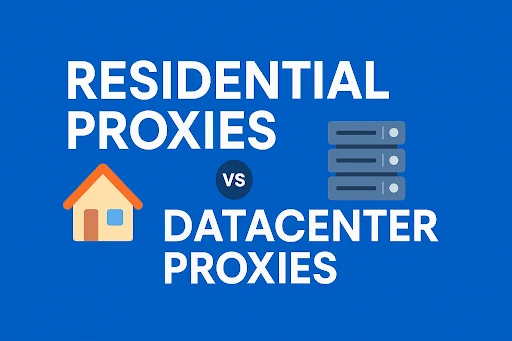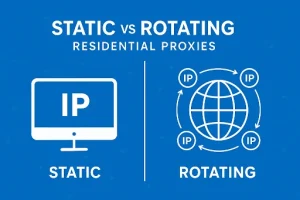
In the world of web scraping, SEO monitoring, and data automation, proxies are the unsung heroes that power millions of online requests daily. Yet, not all proxies are the same.
If you’ve ever wondered what truly separates residential proxies from datacenter proxies, this guide breaks down the technical, practical, and strategic differences — so you can confidently choose the right one for your use case.
What Are Proxies, and Why They Matter
A proxy acts as a middleman between your device and the internet. It hides your real IP address, letting you browse or extract data without revealing your true location or identity.
In simple terms, proxies give you anonymity, security, and control.
But here’s the catch: the source of that IP address determines how websites treat your traffic. That’s why understanding residential vs datacenter proxies is essential.
What Are Residential Proxies?
Residential proxies use IP addresses assigned by Internet Service Providers (ISPs) to real households. When you connect through a residential proxy, websites see your traffic as coming from an actual home user — not from a data center.
Characteristics:
- Assigned by real ISPs
- Tied to home or small business devices
- Rotate across millions of genuine users’ IPs
- Hard to detect or block
- Typically slower but more legitimate-looking
Example use cases:
- Accessing geo-restricted content
- Managing multiple social media accounts
- Bypassing anti-bot systems
- Ad verification and e-commerce monitoring
What Are Datacenter Proxies?
Datacenter proxies come from server farms or cloud providers — not from ISPs. These IPs are “synthetic,” created in bulk and managed through hosting data centers like AWS, Google Cloud, or DigitalOcean.
Characteristics:
- Not tied to ISPs or physical residences
- High-speed and stable
- Easy to deploy in large volumes
- Easier to detect by websites and firewalls
Example use cases:
- High-speed scraping of unprotected websites
- SEO rank tracking
- Price comparison at scale
- Automation testing
Comparison Table: Residential vs Datacenter Proxies
Feature | Residential Proxies | Datacenter Proxies |
|---|---|---|
IP Source | ISP-issued to real households | Generated in cloud data centers |
Authenticity | Appears as a real human user | Recognized as server traffic |
Speed | Moderate, depends on device/connection | Extremely fast and stable |
Detection Risk | Very low | High on anti-bot sites |
Cost | Expensive (per GB model) | Cheaper (per IP or unlimited bandwidth) |
Scalability | Medium | Very high |
Reliability | Can fluctuate | Always consistent |
Best For | Stealth, account management, bypassing blocks | Bulk scraping, SEO tasks, automation |
Geo-targeting | City/region-level accuracy | Limited to data center locations |
How Websites Detect Proxies
Websites use bot detection algorithms and IP reputation databases to identify proxy traffic.
Key signals include:
- ASN (Autonomous System Number) lookup — datacenter IPs usually fall under known hosting ranges.
- Traffic volume patterns — abnormal request rates trigger red flags.
- TLS fingerprints and headers — mismatched browser signatures suggest automation.
- Reverse DNS checks — datacenter IPs often resolve to hosting providers.
👉 Residential proxies bypass many of these checks because they blend in with everyday user traffic — making them ideal for tasks where stealth and legitimacy matter.
Cost vs. Success: The Hidden Tradeoff
At first glance, datacenter proxies look cheaper — sometimes costing as little as $0.10 per IP. But cost per success rate tells a different story.
Let’s say:
- Datacenter proxies succeed 40% of the time due to blocks
- Residential proxies succeed 90% of the time
Even if residential proxies cost more upfront, you save money overall by avoiding failed requests, captchas, and IP bans.
💡 Think of it like using cheaper fuel in a race car — it might cost less, but if it slows you down or breaks your engine, is it really cheaper?
Geolocation & ISP Diversity
One major advantage of residential proxies is geolocation precision. They allow you to:
- Simulate real users from specific cities or even ISPs
- Test local SEO rankings
- Verify ads or content personalization per region
Datacenter proxies, on the other hand, mostly cluster around limited data center regions, which can make your traffic appear suspicious when browsing geo-sensitive websites.
Speed, Stability, and Reliability
- Datacenter proxies = blazing fast, ideal for bulk scraping or automation.
- Residential proxies = slower but more stealthy, perfect for sensitive websites.
However, some hybrid options now exist: ISP or static residential proxies combine the legitimacy of residential IPs with the stability of datacenter networks — giving you the best of both worlds.
When to Use Each Type
Use Case | Recommended Proxy Type | Reason |
|---|---|---|
SEO rank tracking | Datacenter | High speed, low cost |
Social media account management | Residential | Avoid bans and verification triggers |
E-commerce price monitoring | Residential | Evade anti-bot detection |
Data scraping from public sources | Datacenter | Fast and scalable |
Ad verification / brand monitoring | Residential | Geo-targeted and authentic |
Sneaker bots / ticketing sites | Residential | More likely to bypass restrictions |
Common Mistakes & Misconceptions
- “Residential proxies are undetectable.” Not true. Low-quality providers often use infected devices or poor-quality IPs that can still be detected.
- “Datacenter proxies are useless for modern websites.” Not necessarily — they work great for non-protected sites or low-risk scraping.
- “More proxies = more success.” Quality beats quantity. 10 high-quality residential IPs can outperform 1,000 cheap datacenter IPs.
- “All proxy providers are equal.” Always check sourcing transparency, rotation policy, and ethics. Some “residential” networks are built on compromised devices — a huge legal risk.
The Future of Proxies (2025 and Beyond)
- Hybrid proxies (ISP or static residential) are growing fast — offering stability + legitimacy.
- AI-based detection systems are getting smarter, forcing proxy providers to evolve constantly.
- Ethical sourcing is becoming a key differentiator — consent-based proxy networks are gaining trust.
- Geo-fingerprinting detection may soon analyze not just IPs but behavior, making natural traffic simulation even more critical.
In short, the line between datacenter and residential proxies is blurring, but their fundamental roles still differ.
Final Verdict: Which Should You Choose?
If your priority is... | Choose |
|---|---|
Speed, scale, and cost efficiency | Datacenter proxies |
Authenticity, stealth, and bypassing detection | Residential proxies |
A balance of both | ISP / static residential proxies |
Conclusion
Both residential and datacenter proxies have their strengths — the key is aligning them with your specific goal.
If your task involves scraping protected sites, managing accounts, or bypassing complex detection systems, residential proxies will deliver higher success and reliability.
For simpler, volume-driven projects like SEO or market analysis, datacenter proxies are unbeatable for speed and price.
As detection systems evolve, understanding these differences isn’t optional — it’s strategic. The smartest marketers, scrapers, and developers in 2025 use a hybrid approach, switching between proxy types based on performance data and project demands.



